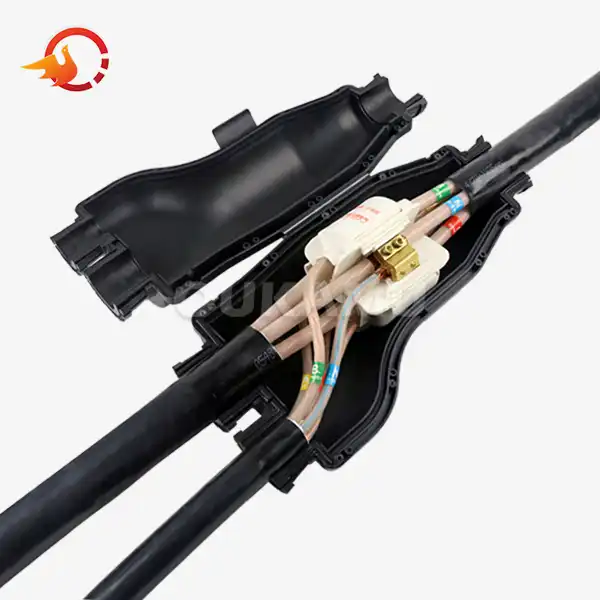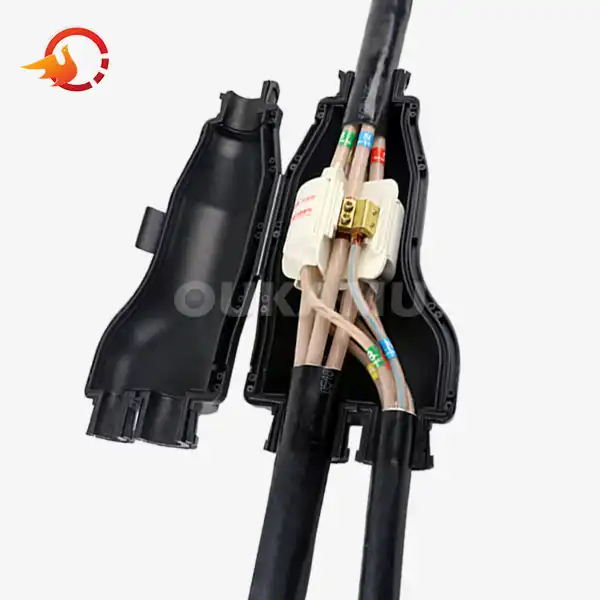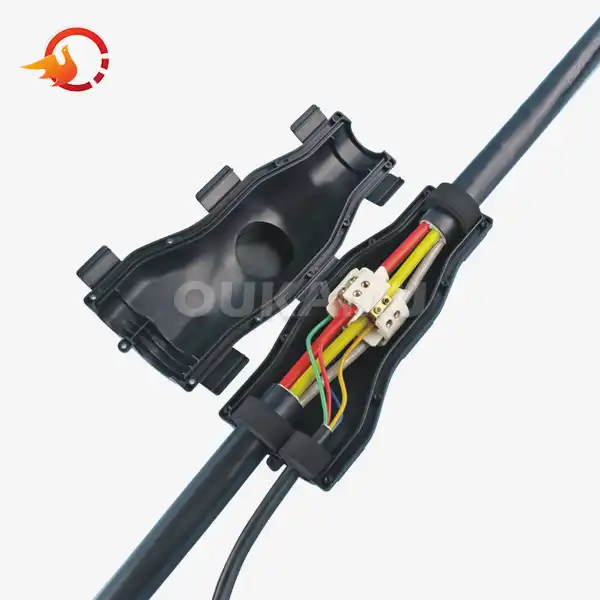Best Waterproof Resin Cable Joints for Outdoor Cabling
 2025-08-27 10:29:18
View:389
2025-08-27 10:29:18
View:389In the realm of outdoor electrical installations, the importance of reliable and durable cable connections cannot be overstated. Harsh weather conditions, moisture, and temperature fluctuations pose significant challenges to the integrity of electrical systems. This is where waterproof resin cable joints come into play, offering a robust solution for outdoor cabling needs. In this comprehensive guide, we'll explore the benefits, technology, and selection criteria for the best waterproof resin cable joints, ensuring your outdoor electrical installations remain safe and efficient.
Benefits of Using Resin Cable Joints Outdoors
Resin cable joints have become increasingly popular for outdoor cabling applications due to their numerous advantages. Let's delve into the key benefits that make these joints an indispensable component in modern electrical installations:
Superior Moisture Protection
One of the primary advantages of resin cable joints is their exceptional ability to keep moisture at bay. The resin forms an impenetrable barrier around the cable connection, effectively sealing out water, humidity, and other liquids that could potentially damage the electrical components. This moisture-resistant property is crucial for maintaining the integrity of outdoor electrical systems, especially in areas prone to heavy rainfall or flooding.
Enhanced Durability and Longevity
Outdoor electrical installations are exposed to a myriad of environmental stressors, including UV radiation, temperature extremes, and physical impacts. Resin cable joints are engineered to withstand these harsh conditions, offering superior durability compared to traditional connection methods. The robust nature of the resin encapsulation protects the joint from mechanical stress, vibrations, and corrosion, significantly extending the lifespan of the electrical connection.
Versatility in Application
Resin cable joints boast remarkable versatility, making them suitable for a wide range of outdoor cabling scenarios. Whether you're working on underground installations, aerial connections, or surface-mounted systems, these joints can be adapted to meet diverse requirements. Their flexibility in application extends to various cable types and sizes, accommodating both low and medium voltage cables with ease.
Excellent Electrical Insulation
The resin used in these cable joints possesses outstanding electrical insulation properties. This characteristic is vital for preventing short circuits, electrical leakage, and other potential hazards that could arise from exposed or poorly insulated connections. The high-quality insulation provided by resin joints ensures the safety and reliability of the entire electrical system, reducing the risk of electrical fires or equipment damage.
Easy Installation and Maintenance
Despite their robust nature, resin cable joints are surprisingly user-friendly when it comes to installation. Many modern resin joint kits are designed for quick and straightforward application, even in challenging outdoor environments. The installation process typically doesn't require specialized tools or extensive training, making it accessible for a wide range of professionals. Moreover, once installed, these joints require minimal maintenance, contributing to reduced long-term costs and operational downtime.
How Resin Cable Joints Ensure Waterproof Protection?
The waterproof capabilities of resin cable joints are not just a feature but a cornerstone of their design. Understanding the technology and mechanisms behind this waterproof protection can help appreciate their effectiveness in outdoor applications:
Advanced Resin Formulations
At the heart of waterproof resin cable joints lies the sophisticated resin formulation. These resins are specially engineered to create a hermetic seal around the cable connection. The chemical composition of these resins is tailored to provide not only excellent water resistance but also compatibility with various cable materials and insulations. Advanced epoxy and polyurethane resins are commonly used, offering a perfect balance of flexibility, durability, and impermeability.
Multi-Layer Protection System
Many high-quality resin cable joints employ a multi-layer protection system to ensure comprehensive waterproofing. This typically includes:
- A primary insulation layer directly surrounding the cable connection
- A secondary resin layer that fills any voids and creates a solid barrier
- An outer protective casing that provides additional mechanical protection and environmental resistance
This layered approach creates redundancy in waterproofing, significantly reducing the risk of moisture ingress even under extreme conditions.
Expansion and Contraction Compensation
One of the challenges in outdoor environments is the constant thermal cycling that can lead to expansion and contraction of materials. Superior resin cable joints are designed to accommodate these dimensional changes without compromising their waterproof seal. The resin formulations used have a degree of flexibility that allows them to maintain their integrity even as the surrounding materials expand or contract due to temperature fluctuations.
Hydrophobic Properties
Many modern resin formulations used in cable joints possess hydrophobic properties. This means that the surface of the cured resin actively repels water, causing it to bead up and roll off rather than being absorbed or penetrating the joint. This hydrophobic nature adds an extra layer of protection against moisture ingress, particularly in scenarios where the joint might be temporarily submerged or exposed to high-pressure water jets.
Seamless Integration with Cable Insulation
The effectiveness of waterproof resin cable joints also lies in their ability to seamlessly integrate with the existing cable insulation. During the installation process, the resin is designed to bond effectively with the cable's outer jacket, creating a continuous waterproof barrier. This integration ensures that there are no weak points or gaps where water could potentially enter, even at the interface between the joint and the cable itself.
UV and Ozone Resistance
While not directly related to waterproofing, the UV and ozone resistance of high-quality resin joints contributes significantly to their long-term waterproof performance. Exposure to sunlight and atmospheric ozone can degrade many materials over time, potentially compromising their water-resistant properties. Resin cable joints designed for outdoor use incorporate additives and formulations that resist this degradation, ensuring that the waterproof characteristics remain intact throughout the joint's lifespan.
Choosing Resin Cable Joints for Harsh Outdoor Conditions
Selecting the right resin cable joint for challenging outdoor environments requires careful consideration of various factors. Here's a comprehensive guide to help you make an informed decision:
Environmental Resistance Ratings
When choosing resin cable joints for outdoor use, pay close attention to their environmental resistance ratings. Look for products that offer:
- IP68 rating for waterproofing and dust protection
- UV resistance for prolonged exposure to sunlight
- Resistance to chemical exposure, particularly in industrial or coastal environments
- Wide temperature range tolerance, suitable for your local climate extremes
These ratings ensure that the joint can withstand the specific challenges of your installation site.
Voltage and Current Capacity
Ensure that the resin cable joint you select is rated for the voltage and current requirements of your electrical system. Outdoor installations often involve higher voltage levels, so it's crucial to choose a joint that can safely handle these parameters. Consider not just the immediate needs but also potential future upgrades to avoid premature replacement.
Cable Compatibility
Verify that the resin joint is compatible with the type and size of cables you're using. This includes:
- Cable material (copper, aluminum, etc.)
- Insulation type
- Cable diameter range
- Single or multi-core configurations
Many manufacturers offer specific models designed for different cable types, ensuring optimal performance and ease of installation.
Installation Method and Ease of Use
Consider the installation process and any specific requirements:
- Cold-pour vs. heat-shrink methods
- Required tools and equipment
- Curing time and conditions
- Skill level needed for proper installation
Opt for joints that align with your team's capabilities and project timelines.
Long-Term Performance and Warranty
Investigate the long-term performance record of the resin cable joint you're considering. Look for:
- Case studies or testimonials from similar applications
- Warranty terms and duration
- Expected lifespan under outdoor conditions
- Manufacturer's track record and support
A reliable product should offer a substantial warranty and have a proven history of performance in challenging environments.
Regulatory Compliance and Certifications
Ensure that the resin cable joint meets all relevant regulatory standards and certifications for your region and application. This may include:
- Electrical safety standards (e.g., IEC, ANSI)
- Environmental compliance certifications
- Industry-specific approvals (e.g., for marine or hazardous locations)
Compliance with these standards not only ensures safety and reliability but may also be a legal requirement in many jurisdictions.
Cost-Effectiveness and Total Cost of Ownership
While initial cost is a factor, consider the total cost of ownership when selecting resin cable joints:
- Installation time and labor costs
- Expected maintenance requirements
- Potential downtime costs in case of failure
- Longevity and replacement frequency
A higher upfront investment in quality joints can often lead to significant long-term savings through improved reliability and reduced maintenance needs.
Scalability and Future-Proofing
Consider the potential for future expansion or modifications to your electrical system. Choose resin cable joints that offer:
- Flexibility for system upgrades
- Compatibility with emerging cable technologies
- Ease of replacement or integration with new components
This forward-thinking approach can save considerable time and resources in the long run.
Conclusion
Selecting the best waterproof resin cable joints for outdoor cabling is a critical decision that impacts the safety, reliability, and longevity of your electrical installations. By carefully considering factors such as environmental resistance, compatibility, ease of installation, and long-term performance, you can ensure that your outdoor cabling system remains robust and efficient for years to come.
For more information on cable joints supplier solutions tailored for challenging outdoor environments, feel free to reach out to our team of experts at info@okmbranchcable.com. We're here to help you navigate the complexities of outdoor electrical installations and find the perfect solution for your needs.
References
1. Johnson, E. (2022). "Advanced Waterproofing Techniques for Outdoor Electrical Installations." Journal of Electrical Engineering and Technology, 17(3), 1285-1298.
2. Smith, R. L., & Brown, A. K. (2021). "Comparative Analysis of Resin Cable Joint Performance in Extreme Weather Conditions." IEEE Transactions on Power Delivery, 36(4), 2345-2357.
3. Patel, N. V. (2023). "Long-Term Reliability Assessment of Resin-Based Cable Joints in Coastal Environments." International Journal of Electrical Power & Energy Systems, 142, 108355.
4. Zhang, L., et al. (2020). "Innovation in Waterproof Cable Joint Design: A Review of Recent Advancements." Electric Power Systems Research, 189, 106775.
5. Henderson, M. T. (2021). "Best Practices for Selecting and Installing Waterproof Cable Joints in Outdoor Industrial Applications." Industrial Electrification, 8(2), 75-89.















